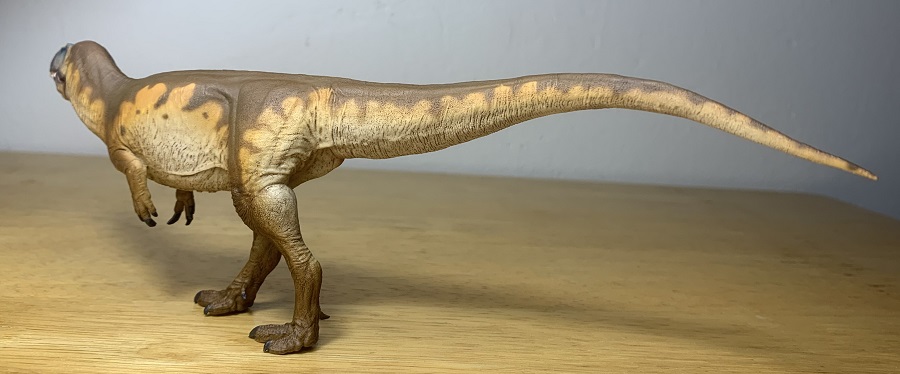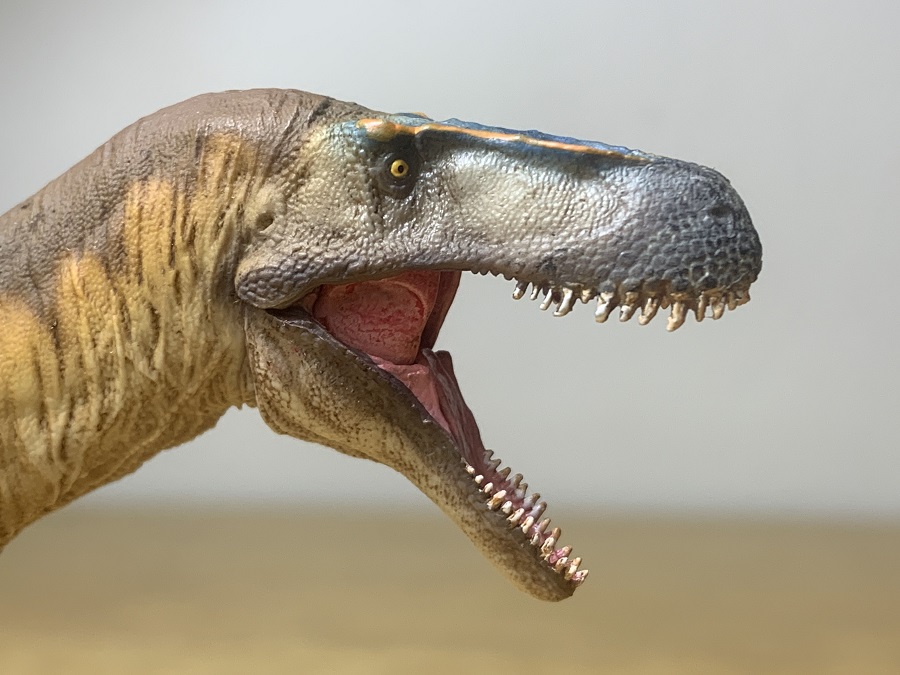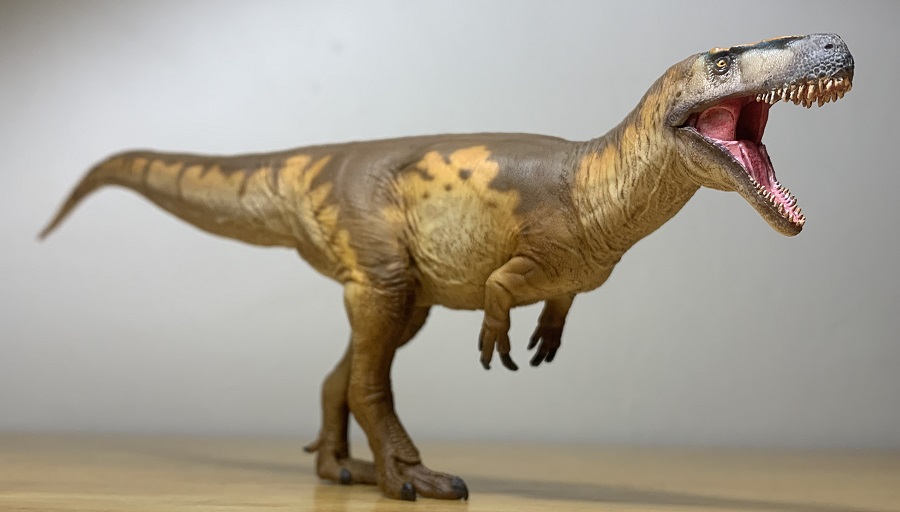Megalosaurus isn’t a particularly awe inspiring animal as theropods go. It doesn’t have the strength and size of Tyrannosaurus, the bizarre adaptations of Spinosaurus, the horns of Carnotaurus, or even the rich fossil record of little ol’ Coelophysis. And maybe that’s why there aren’t many toys of it. But Megalosaurus has something that no other theropod has or ever will, it was the first non-avian dinosaur to be scientifically described (in 1824) by Homo sapiens and one of three dinosaurs used to erect and define the dinosauria clade, back in 1842. For that reason, it is one of the most historically significant theropods, or prehistoric animals in general, to ever be discovered.


I’ve been collecting dinosaurs for about 12 years now. One of the first figures I got was the Invicta Megalosaurus, a vintage throwback from my youth, and although I will always adore that figure (historically noteworthy in its own right) my heart has desired a more modern depiction of this important dinosaur. A few have come around but none that really appealed to me until 2023, when PNSO released the Megalosaurus I’ve been waiting for.

The PNSO Megalosaurus, named Edward, measures about 9” (23 cm) long and stands about 2.7” (7 cm) tall to the top of the head. Megalosaurus is estimated to have measured between 20-30’ (6-9 meters) which would put PNSO’s model between 1/26 and 1/40 in scale and thus it fits into the often-desired 1/35 scale.

The figure is presented in a static pose with the right foot forward of the left. Although it comes with a support rod the rod seems somewhat useless in this case and the model is not as stable as you would hope, with or without the rod. In my cabinet I’m keeping Edward close to another dinosaur, to soften his almost inevitable fall. I would still suggest using the support rod though, as it should at least keep the model from warping and leaning forward.

Although static in pose there is great fluidity of movement here, particularly with the tail, which attractively sweeps up and to the left with the tip dipping back down. The body is held horizontally with the torso dipping down slightly, but the head lifted and level with the tail and looking rightward. The relaxed arms hang down along the sides. The articulated jaw is well executed, as you probably already expect. It’s small and delicate though, so use caution when initially playing with it.


Megalosaurus is known from a decent assortment of bones but no complete skeletons. Thankfully, what we have gives us a general idea of what Megalosaurus looked like and material from related animals, like Torvosaurus and Wiehenvenator, helps too. Megalosaurus was pretty standard in form as theropods go, with its most distinctive characteristic being its narrow, rectangular head with squared off snout, which Edward nicely displays here.

The figure does have exposed teeth and like many of PNSO’s past theropods they’re a bit overexposed. That, along with the brown wash applied to them, gives the illusion that this theropod has a bad case of mouth rot. That said, I’m not about to take an otherwise excellent Megalosaurus figure to task over it and can look past the teeth, which are small enough to ignore.

Looking closer at the details we’ll start at the head where large, crocodile-like, pressure sensitive scales are sculpted around the snout. These extend from the tip of the snout to the end of the maxilla. The rest of the head is covered in fine, pebbly scales. The fenestra on the skull are slightly visible under the skin, but I wouldn’t call the head shrink-wrapped. The jawbones are nicely defined with wrinkled skin between the mandibles and along the neck.


The arms are small but robust and well-muscled. The claw on the first digit is slightly larger than the others and they’re all surprisingly pointy, as are the toe claws. Along the back the spine is nicely accentuated by a raised ridge and the torso is well rounded. The hips are slightly visible under the skin and the tail is amply robust at its base. There is, of course, a sculpted cloaca. The entirety of the figure is covered in minute pebbly scales and organically placed skin folds and wrinkles that conform with the animal’s anatomy and movement. The toes have additional bird-like tarsal scutes sculpted on them and foot pads on the underside. The feet themselves are appropriately lean but up past the ankles we have some bulging calf and thigh muscles.


It’s a PNSO figure, so the paint job is what you should expect it to be. Brown. Dark brown patterning runs down the back and bleeds down along the sides. The underside is a paler shade of brown. I could leave it there, but the truth is that even though it’s the same boring old colors and patterns it’s also exceptionally well done. Along the edges of the dark dorsal patterning there’s a brighter shade of brown, almost orange I would say, that beautifully blends into the pale underside. The head is gray, and we do get a splash of vibrant color in the form of orange highlights painted over the shiny keratinous ridges running along the top of the head. Between the ridges we get a splash of vivid blue. The intricately sculpted inside of the mouth, and the tongue, are red and pink with a shiny gloss. The eyes are yellow with black pupils and the claws are all painted black. Paint application is second to none, as usual with PNSO.


I don’t hate the brown, and I have so few PNSO theropods that Edward won’t get lost in a crowd of larger brown theropods. It’s naturalistic and makes sense for a large predator. That said, I do wish that PNSO would get a bit more adventuresome, at least with patterns, because the stripes and splotches along the back are more boring than the color itself.

Edward the Megalosaurus has a few of PNSO’s typical problems but it’s also a PNSO theropod, and it’s hard to deny that they have the market cornered on theropods. Shortcomings aside, this is the best plastic Meglosaurus to come along since Invicta’s in 1974. And although I might be biased, this is definitely among the year’s top ten for me. PNSO released a lot of tyrannosaurs and carcharodontosaurs this year, but this is the one that got me excited. The PNSO Megalosaurus is widely available online and retails for about $30.99.

Disclaimer: links to Ebay and Amazon on the DinoToyBlog are affiliate links, so we make a small commission if you use them. Thanks for supporting us!





Bocsánat,de nem vagyok elájulva ettől a modelltől.A CollectA 2021-es verziójának legalább volt némi karaktere.Ezzel egyébként részemrőla legnagyobb probléma a fej,a teljes fej.
A splendid figurine all around. Megalosaurus definitely deserves more toys to its name, but now I doubt many could match this one in quality.